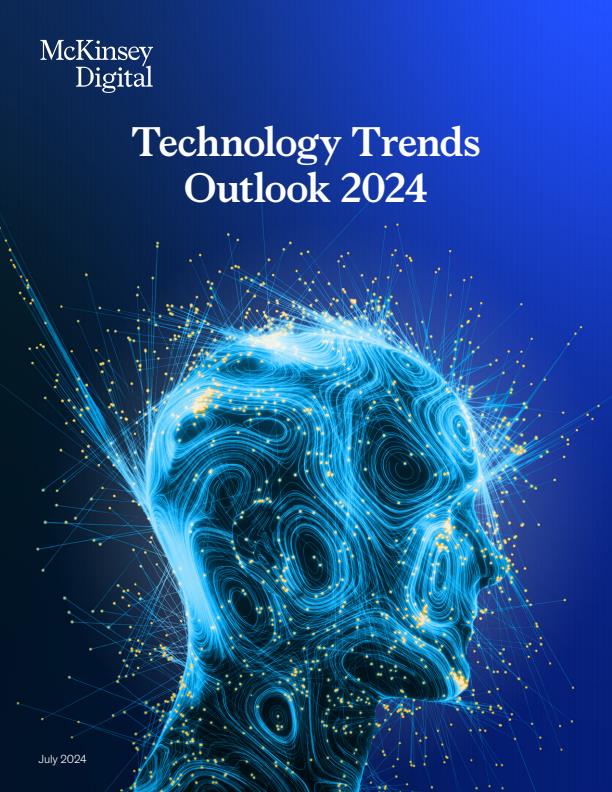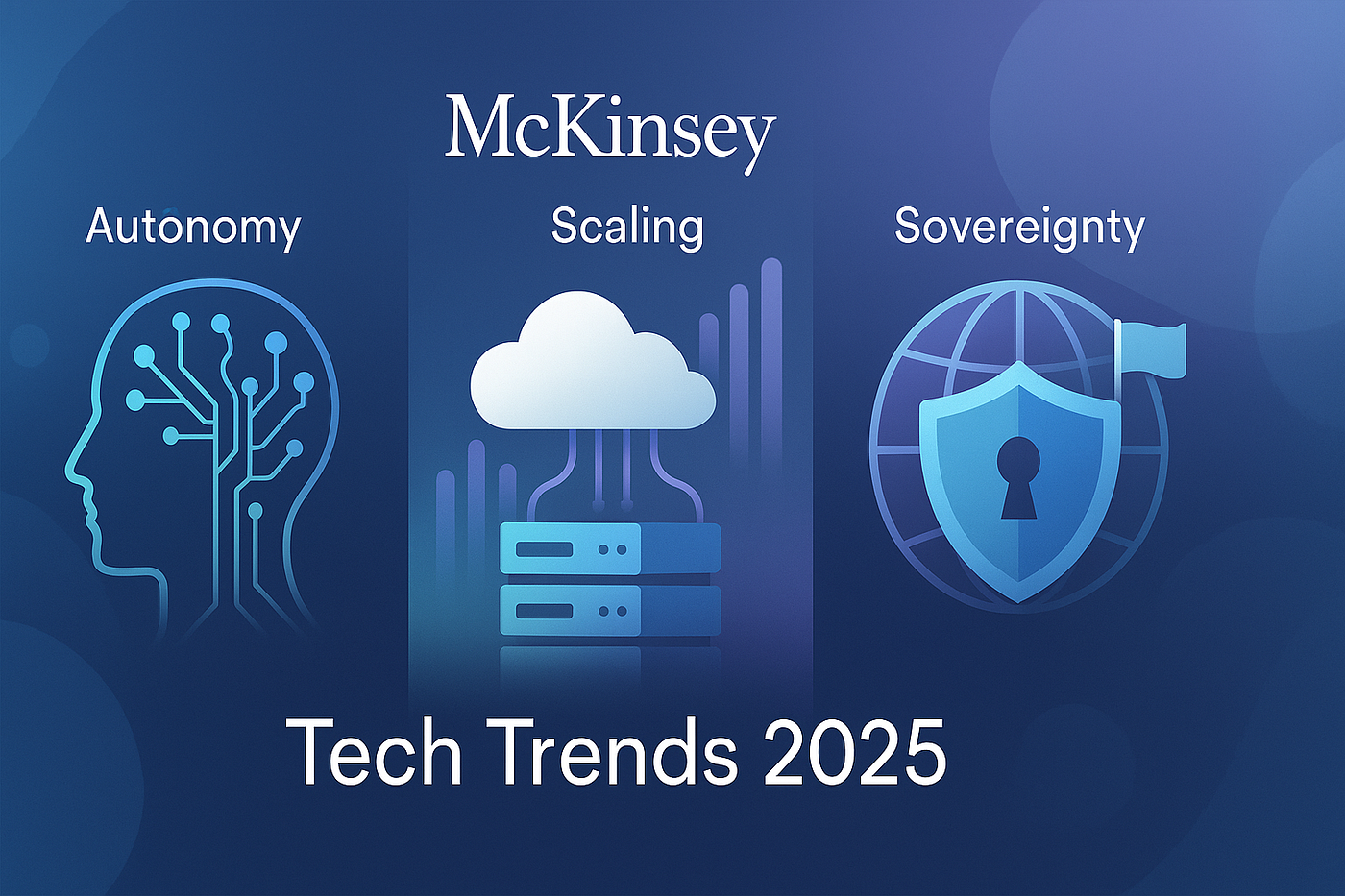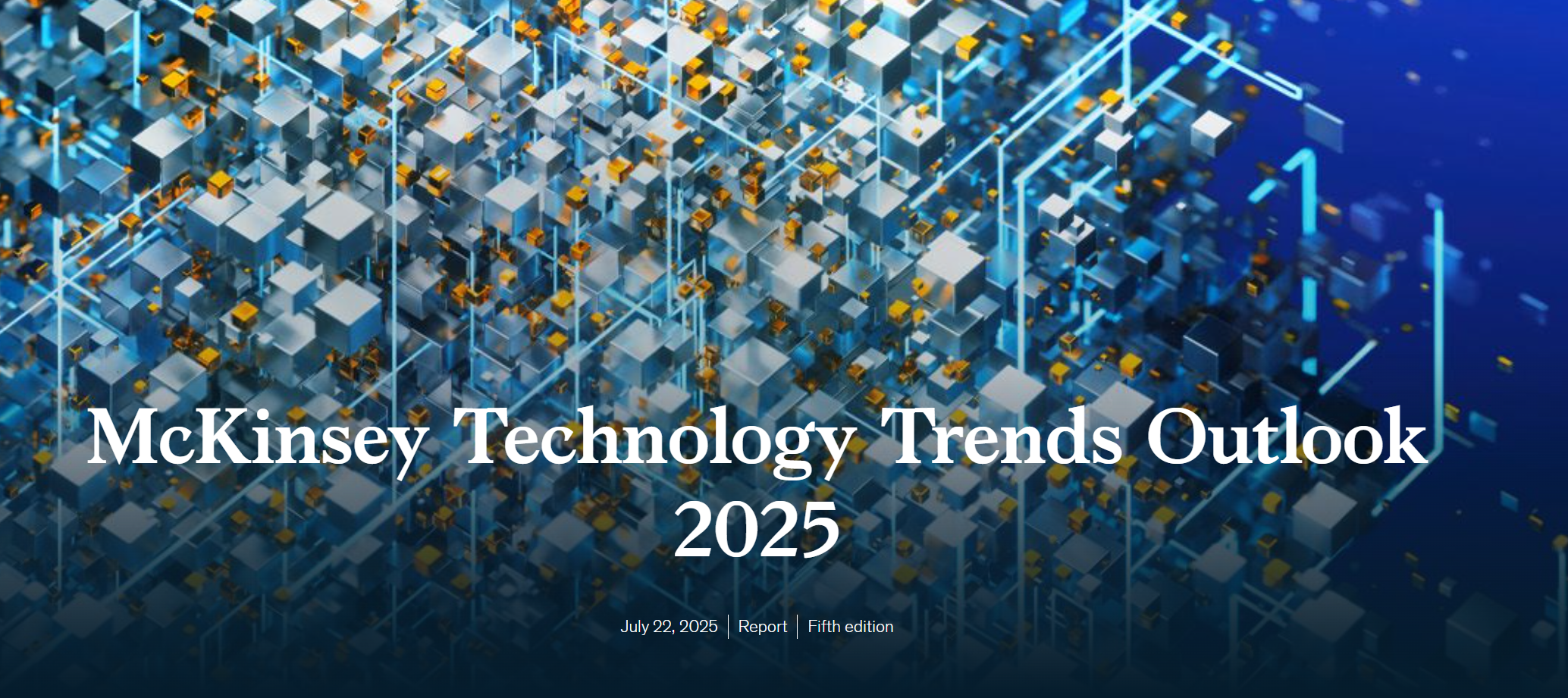“`html
Charting the Technological Horizon for 2025
Estimated reading time: 15 minutes
Key Takeaways
- The pace of technological change is accelerating, making it crucial for businesses to stay ahead.
- The McKinsey technology trends outlook 2025 provides a vital roadmap for understanding future business landscapes.
- Understanding emerging technology in 2025 is a strategic imperative for growth and survival, not an option.
- McKinsey identifies 13 frontier tech trends categorized into AI revolution, engineering breakthroughs, and compute and technology frontiers.
- Agentic AI, domain-specific AI, and application-specific semiconductors are key technologies to watch.
- Artificial intelligence is the foundational amplifier for many future trends, driving automation, data analysis, customer experience, and innovation.
- Proactive business transformation, strategic investment, and workforce upskilling are essential for leveraging these technologies.
Table of Contents
- Introduction: Charting the Technological Horizon for 2025
- The McKinsey Framework: Deconstructing the 13 Frontier Tech Trends
- Spotlight on Key Frontier Technologies: Beyond the Hype
- The AI Revolution: The Cornerstone of Business Transformation
- Strategic Imperatives: Driving Business Transformation with Technology
- Actionable Steps: Navigating the McKinsey Technology Trends Outlook 2025
- Concluding Thoughts: Embracing the Future of Business Technology
In today’s rapidly evolving business landscape, standing still is not an option. The relentless march of technological innovation is reshaping industries, redefining competitive advantages, and presenting both unprecedented opportunities and significant challenges. To navigate this dynamic future successfully, businesses must not only be aware of emerging trends but actively integrate them into their strategic vision. This is where resources like the McKinsey technology trends outlook 2025 become indispensable. This outlook serves as a critical compass, guiding organizations through the complex terrain of technological advancement. Our purpose here is to provide a comprehensive overview of McKinsey’s key findings, dissecting the most impactful trends and exploring their profound implications for business transformation. Indeed, understanding emerging technology in 2025 has transcended mere curiosity; it has become a non-negotiable prerequisite for sustained growth, competitive relevance, and long-term survival.
The McKinsey Framework: Deconstructing the 13 Frontier Tech Trends
McKinsey’s latest report delves deep into the technologies poised to make the most significant impact in the coming years, meticulously identifying and analyzing 13 frontier tech trends. This comprehensive framework is not based on speculation but on rigorous data-driven analysis. McKinsey employs a sophisticated methodology to pinpoint these pivotal trends, utilizing a suite of quantitative indicators. These include tracking equity investment in nascent technologies, analyzing talent flows across the tech sector, monitoring patent activity as a proxy for innovation, and assessing the extent of enterprise adoption of new solutions. This multifaceted approach ensures that the identified trends are not fleeting fads but technologies with demonstrable momentum and potential for widespread impact. (Source: https://www.mckinsey.com/capabilities/mckinsey-digital/our-insights/the-top-trends-in-tech)

To provide clarity and strategic focus, McKinsey thoughtfully categorizes these 13 trends into three overarching themes: the AI revolution, engineering breakthroughs, and compute and technology frontiers. This structure helps businesses understand the interconnectedness of these advancements and how they build upon one another. (Source: https://www.mckinsey.com/featured-insights/mckinsey-live/webinars/the-future-of-business-13-tech-trends-that-matter)
While the profound influence of artificial intelligence is undeniable and forms a central pillar of this outlook, it is crucial to recognize that the technological frontier extends far beyond AI alone. Indeed, understanding emerging technology in 2025 requires a holistic view that embraces advancements across all three categories. (Source: https://www.mckinsey.com/featured-insights/mckinsey-live/webinars/the-future-of-business-13-tech-trends-that-matter)

To aid leaders in prioritizing their strategic investments, McKinsey introduces an “enterprise adoption score.” This score provides a quantifiable measure of how likely a particular technology is to be adopted by businesses, offering valuable insights into its potential impact and the urgency for exploration and integration. (Source: https://www.mckinsey.com/capabilities/mckinsey-digital/our-insights/the-top-trends-in-tech)
Spotlight on Key Frontier Technologies: Beyond the Hype
Agentic AI: The Evolution to Digital Coworkers
Perhaps one of the most transformative trends identified is Agentic AI. Moving beyond the capabilities of traditional AI systems that primarily focus on content generation or simple task execution, Agentic AI refers to sophisticated systems capable of autonomously planning, executing, and managing multi-step workflows. These are not just tools; they are emerging as digital collaborators or “digital coworkers” that can handle complex operational tasks with minimal human intervention. (Source: https://dhinsights.org/blog/mckinseys-2025-tech-trends-report-finds-healthcare-caught-between-ai-promise-and-perils/)

The potential applications of Agentic AI are vast and already being demonstrated in various sectors. In healthcare, for instance, these systems can autonomously manage administrative processes such as patient scheduling, comprehensive documentation, and even the detection of critical anomalies in medical data. Early pilot cases have shown remarkable productivity gains, with some studies suggesting improvements as high as 60% in specific workflows. This level of automation promises to free up human professionals to focus on higher-value, more complex, and patient-facing activities. (Source: https://dhinsights.org/blog/mckinseys-2025-tech-trends-report-finds-healthcare-caught-between-ai-promise-and-perils/)
However, the rapid advancement and adoption of Agentic AI are not without their challenges. As these systems become more autonomous and integrated into critical business functions, critical questions surrounding governance, liability, and the establishment of trust become paramount. This is especially true in highly regulated and sensitive sectors like healthcare, where the stakes for errors or misjudgments are exceptionally high. Establishing robust frameworks for oversight and accountability will be essential for widespread adoption. (Source: https://dhinsights.org/blog/mckinseys-2025-tech-trends-report-finds-healthcare-caught-between-ai-promise-and-perils/)
Despite the lower absolute investment compared to some more established technologies, Agentic AI exhibits a notably high growth rate. This strong upward trajectory signals its significant disruptive potential, indicating that it is a trend that businesses cannot afford to ignore as part of the McKinsey 13 frontier tech trends and essential for understanding emerging technology in 2025. (Source: https://www.mckinsey.com/featured-insights/mckinsey-live/webinars/the-future-of-business-13-tech-trends-that-matter)
Domain-Specific AI: Democratizing Advanced Capabilities
Complementing the broader AI revolution, domain-specific AI models represent a significant leap in making advanced artificial intelligence more accessible and practical for a wider range of organizations. These are not the monolithic, resource-intensive AI models that often come to mind. Instead, they are smaller, specialized AI models that are fine-tuned for particular industries or tasks. They offer advanced functionalities without demanding massive cloud infrastructure or extensive computational resources.

The benefits of domain-specific AI are particularly pronounced for organizations operating with limited budgets or those with stringent data privacy requirements. By enabling localized AI deployment, these models can significantly reduce the risk of data leakage, enhance data security, and provide greater control over AI processes. This is especially relevant for sectors like healthcare, finance, and legal services, where data confidentiality is paramount. Furthermore, their tailored nature means they can often achieve higher accuracy and efficiency for specific applications compared to general-purpose AI. The focus on these specialized models is a critical aspect of understanding emerging technology in 2025.
Application-Specific Semiconductors: Powering Specialized Performance
Underpinning many of these advancements, particularly in AI and edge computing, is the rise of application-specific semiconductors. Unlike general-purpose processors (CPUs) found in most computers, these specialized chips are meticulously engineered to excel at particular tasks. This includes accelerating AI inference, optimizing data processing at the edge of networks, and powering high-performance computing applications. Their bespoke design allows them to achieve significantly higher performance and energy efficiency compared to their more generalized counterparts. (Source: https://www.mckinsey.com/capabilities/mckinsey-digital/our-insights/the-top-trends-in-tech)

The escalating demand for specialized compute power across virtually every industry is driving the development and adoption of these chips. From autonomous vehicles to advanced medical imaging and complex scientific simulations, application-specific semiconductors are becoming indispensable enablers. They play a crucial role in making faster, more efficient, and more powerful AI deployments a reality, both in data centers and at the edge. Their inclusion in the McKinsey 13 frontier tech trends highlights their fundamental importance for achieving essential business technology trends 2025.
The AI Revolution: The Cornerstone of Business Transformation
It is impossible to overstate the central role of artificial intelligence in the current and future technological landscape. As highlighted in McKinsey’s outlook, Artificial intelligence serves as the foundational amplifier for many of the trends discussed. It is the engine that drives automation, unlocks deep insights from data, enables sophisticated decision-making, and facilitates the creation of entirely new business models. AI is not just a technology; it’s a catalyst for fundamental business change. (Source: https://www.mckinsey.com/~/media/mckinsey/email/monthly/2025/2025-08-02a.html)

The rapid maturation of AI, particularly in areas like generative AI and multimodal AI (which can process and understand various types of data like text, images, and audio), is driving widespread adoption. A significant percentage of organizations are already utilizing AI in some capacity, with a strong intention to increase their investments in the near future. This indicates a broad recognition of AI’s strategic value across industries. (Source: https://dhinsights.org/blog/mckinseys-2025-tech-trends-report-finds-healthcare-caught-between-ai-promise-and-perils/)
The impact of AI is multifaceted and spans critical areas of business operations:
- Automation: Driven by technologies like Agentic AI and advanced robotics, AI is streamlining operations, reducing manual effort, and increasing efficiency across a wide range of tasks. (Source: https://dhinsights.org/blog/mckinseys-2025-tech-trends-report-finds-healthcare-caught-between-ai-promise-and-perils/)
- Data Analysis: AI excels at processing and deriving insights from vast datasets, accelerating research and development cycles, and enabling hyper-personalized customer experiences. (Source: https://dhinsights.org/blog/mckinseys-2025-tech-trends-report-finds-healthcare-caught-between-ai-promise-and-perils/)
- Customer Experience: AI-powered interfaces, intelligent recommendation engines, and personalized communication channels are significantly enhancing customer engagement and satisfaction. (Source: https://dhinsights.org/blog/mckinseys-2025-tech-trends-report-finds-healthcare-caught-between-ai-promise-and-perils/)
- Innovation: AI is accelerating scientific discovery and engineering breakthroughs. A prime example is the advancement in protein structure prediction, such as with AlphaFold 3, which has profound implications for drug discovery and biotechnology. (Source: https://dhinsights.org/blog/mckinseys-2025-tech-trends-report-finds-healthcare-caught-between-ai-promise-and-perils/)

Despite the immense potential and increasing adoption, there remains a notable gap between AI’s capabilities and the actual level of mature adoption within organizations. While many companies are experimenting with or implementing AI, only a small percentage report having fully mature AI strategies and capabilities embedded across their operations. Bridging this gap is a key challenge and opportunity for achieving the full impact of AI on business transformation, as detailed in the McKinsey technology trends outlook 2025.
Strategic Imperatives: Driving Business Transformation with Technology
The insights from McKinsey’s technology trends outlook underscore a critical message: embracing these advancements requires more than just passive awareness; it demands proactive business transformation. Organizations must fundamentally rethink their strategies, operations, and cultures to harness the power of these emerging technologies effectively. (Source: https://www.mckinsey.com/~/media/mckinsey/email/monthly/2025/2025-08-02a.html)
To achieve a competitive edge in this evolving landscape, businesses should focus on leveraging these technologies across several key dimensions:
- Innovate Products and Services: Utilize AI and engineering breakthroughs to develop novel offerings that differentiate from competitors and meet emerging customer needs.
- Optimize Operations: Implement advanced connectivity, computing solutions, and AI-driven automation to streamline processes, reduce costs, enhance efficiency, and increase agility.
- Enhance Customer Engagement: Leverage immersive realities and personalized AI-driven interactions to create superior customer experiences that foster loyalty and drive value.
- Build Competitive Advantage: Make strategic investments in early-stage technologies with high potential, foster a culture that embraces rapid learning and experimentation, and adapt quickly to market shifts. (Source: https://www.mckinsey.com/~/media/mckinsey/email/monthly/2025/2025-08-02a.html)

Furthermore, the McKinsey report highlights that successful transformation hinges not only on technology adoption but also on critical supporting elements. These include investing in digital upskilling to ensure the workforce has the necessary competencies, developing adaptable leadership capable of navigating complex change, and proactively understanding and responding to evolving global trade policies and their impact on technology supply chains. (Source: https://www.mckinsey.com/~/media/mckinsey/email/monthly/2025/2025-08-02a.html)
Understanding these essential business technology trends 2025 and aligning them with strategic imperatives is key to unlocking competitive advantage and achieving sustainable growth. The impact of AI on business transformation is profound, but it requires a comprehensive approach that addresses people, processes, and strategy alongside technology.
Actionable Steps: Navigating the McKinsey Technology Trends Outlook 2025
To effectively navigate the landscape outlined in the McKinsey technology trends outlook 2025, businesses need a clear, actionable roadmap. Moving from awareness to implementation requires a structured approach. Here are concrete steps organizations can take:
- Assess Current Capabilities: Begin with a thorough audit of your organization’s existing technology stack, workforce skills, and operational processes. Identify current strengths, weaknesses, and critical gaps that need to be addressed to capitalize on emerging trends. This assessment is crucial for understanding where to focus efforts. (Source: https://www.mckinsey.com/~/media/mckinsey/email/monthly/2025/2025-08-02a.html)
- Invest Strategically: Prioritize technology investments based on their alignment with core business objectives and their potential for high impact. This might involve focusing on agentic AI for automating specific workflows, investing in domain-specific AI for enhanced data analysis, or adopting specialized semiconductors to boost performance in critical areas. The key is to be deliberate and data-informed in investment decisions. (Source: https://www.mckinsey.com/capabilities/mckinsey-digital/our-insights/the-top-trends-in-tech)
- Develop a Future-Ready Workforce: Invest significantly in upskilling and reskilling your employees. Focus on developing competencies in areas such as AI, data science, cybersecurity, and the effective use of new engineering tools. Addressing talent shortages proactively through continuous learning programs is vital for successful technology adoption.
- Foster an Innovation Culture: Create an environment that encourages experimentation, allows for rapid prototyping, and promotes cross-functional collaboration. A culture that embraces agility and learning from both successes and failures will accelerate the adoption and scaling of new technologies. (Source: https://www.mckinsey.com/~/media/mckinsey/email/monthly/2025/2025-08-02a.html)

By taking these actionable steps, businesses can move beyond merely observing technological shifts to actively shaping their future. The McKinsey technology trends outlook 2025 provides the foresight, and these steps provide the framework for execution, ensuring organizations are well-positioned to benefit from the essential business technology trends 2025.
Concluding Thoughts: Embracing the Future of Business Technology
The McKinsey technology trends outlook 2025 paints a compelling picture of a future driven by rapid technological evolution. The most critical takeaways emphasize the imperative for businesses to not just adapt but to lead through proactive transformation. The profound impact of AI on business transformation is undeniable, acting as a linchpin for many of these advancements. Equally important is the necessity of actively embracing and understanding emerging technology in 2025 across all its facets – from intelligent automation to specialized compute power and engineering breakthroughs.

Ultimately, thriving amidst future disruption and uncertainty hinges on the strategic and timely adoption of these essential business technology trends. This requires foresight, a willingness to invest, and a commitment to building the organizational capabilities needed to leverage these powerful new tools. The journey begins with a strategic assessment and a clear vision for how technology can redefine your business in the years to come.
Frequently Asked Questions
What are the primary categories of McKinsey’s 13 frontier tech trends?
McKinsey categorizes the 13 frontier tech trends into three broad groups: the AI revolution, engineering breakthroughs, and compute and technology frontiers.
How does McKinsey identify these technology trends?
McKinsey uses a data-driven methodology that includes analyzing equity investment, talent flows, patent activity, and enterprise adoption rates to identify and validate the significance of these trends.

What is Agentic AI and why is it important?
Agentic AI refers to systems that can autonomously plan and execute multi-step workflows, essentially acting as digital coworkers. They are important because they represent a significant advancement in automation and have the potential to dramatically increase productivity in various sectors.
Are there specific challenges associated with adopting Agentic AI?
Yes, key challenges include establishing robust governance frameworks, addressing liability concerns, and building trust, especially in sensitive industries like healthcare.
How do domain-specific AI models differ from general AI models?
Domain-specific AI models are smaller, specialized AI systems trained for particular tasks or industries. They offer advanced capabilities without requiring massive infrastructure, making them more accessible and cost-effective for many organizations.

What role do application-specific semiconductors play in technological advancement?
Application-specific semiconductors are chips designed for particular tasks (like AI inference or edge computing), providing higher performance and efficiency than general-purpose chips. They are crucial for enabling the specialized compute power needed for advanced AI and other cutting-edge technologies.
Why is understanding emerging technology considered a strategic imperative for businesses in 2025?
Understanding emerging technology is a strategic imperative because the pace of technological change is accelerating, and businesses that fail to adapt risk falling behind competitors, losing market relevance, and jeopardizing their long-term survival and growth prospects.

What are some key actions businesses should take to leverage these technology trends?
Key actions include assessing current capabilities, investing strategically in prioritized technologies, developing a future-ready workforce through upskilling, and fostering a culture of innovation and rapid learning.
What is the significance of AI in the context of these technology trends?
AI is considered the foundational amplifier for many of the trends. It drives automation, enhances data analysis, improves customer experiences, and accelerates innovation across various fields, making it central to business transformation.
Is AI adoption already mature across all industries?
No, while AI adoption is growing rapidly, only a small percentage of organizations report having fully mature AI capabilities. There remains a significant gap between AI’s potential and its widespread, deep integration into business operations.

“`



